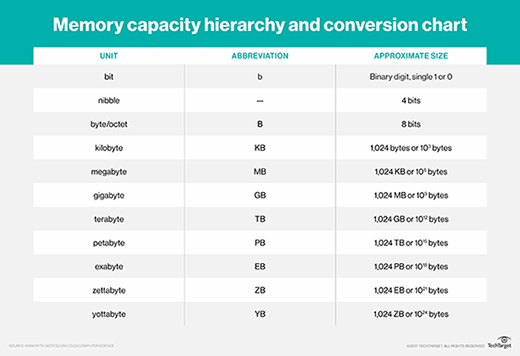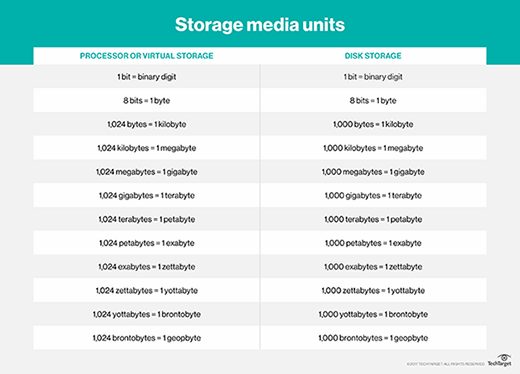TB vs. GB: Is a terabyte bigger than a gigabyte?
A terabyte comprises more than 1 trillion bytes. Discover how the storage measurement scale was created and where a terabyte stands among other units of measurement today.
As the amount of data we generate continues to grow, so does the list of units to measure it. The humble byte is now attached to a slew of prefixes denoting vast amounts of data.
A terabyte (TB), for example, is equal to 1012 bytes. Hitachi released the first terabyte-level hard drive in 2007, and today, HDDs can hold up to 18 TB of data. The largest SSDs can hold up to 100 TB. An LTO-9 tape cartridge features compressed capacity up to 45 TB.
On their own, these massive storage capacities are nearly incomprehensible. By comparing these units of measurement, however, it's easier to gain a clear picture. To understand what a terabyte is, it helps to know what is bigger and smaller than one.
Is a TB bigger than a GB?
A terabyte is bigger than a gigabyte.
A terabyte is equal to 1,024 gigabytes (GB), which itself is equal to 1,024 megabytes (MB), while a megabyte is equivalent to 1,024 kilobytes. All storage measuring units -- kilobyte, megabyte, terabyte, gigabyte, petabyte, exabyte and so on -- are multiples of a byte.
How the size scale was created
Bytes hold a string of bits, typically eight for most computer systems. A bit, short for binary digit, has a single binary value of either 0 or 1 and is the smallest unit of data in a computer system. Memory or storage devices typically store the value of a bit above or below a designated level of electrical charge in a single capacitor. A byte holds its string of bits so they can be used in a larger unit for application or OS purposes.

Werner Buchholz is credited by Fred Brooks -- author of the classic software engineering tome The Mythical Man-Month: Essays on Software Engineering and an early IBM hardware architect and IBM System/360 OS project manager -- as the originator of the term byte. According to Brooks, Buchholz came up with byte while helping to design IBM's first transistorized supercomputer, the 7030 STRETCH, in 1956.
Terabyte vs. other byte measures
Measurements that are smaller than a terabyte include a kilobyte, megabyte and gigabyte.
A terabyte is one of the largest units of storage media that products on the market use today, but it is not the biggest unit of measurement in data storage. Units larger than a terabyte include a petabyte, exabyte, zettabyte, yottabyte and brontobyte. A geopbyte is also larger than a terabyte and refers to 1030 bytes, or 1,000 brontobytes.
Additional units of measurement become necessary as the amount of data in the world increases. And it's not going to slow down any time soon. Actual drive capacity may not currently go beyond the terabyte scale, but this will undoubtedly change as storage media technology evolves.
To further explore TB vs. GB and how other units compare, refer to the below chart.

How much data is in a terabyte?
A terabyte has a storage drive capacity of about 1 trillion bytes or, more specifically, 1,099,511,627,776 bytes; 1,073,741,824 kilobytes; or 1,048,576 megabytes.
In practical terms, a terabyte of data is equivalent to the following:
- 728,177 floppy disks
- 1,498 CD-ROM discs
- 212 DVD discs
- 40 single-layer Blu-ray discs
- 85,899,345 pages of Word documents
- 132,150 650-page books
- 500 hours of movies
- 1,000 hours of video
- 310,000 photos
- 17,000 hours of music






